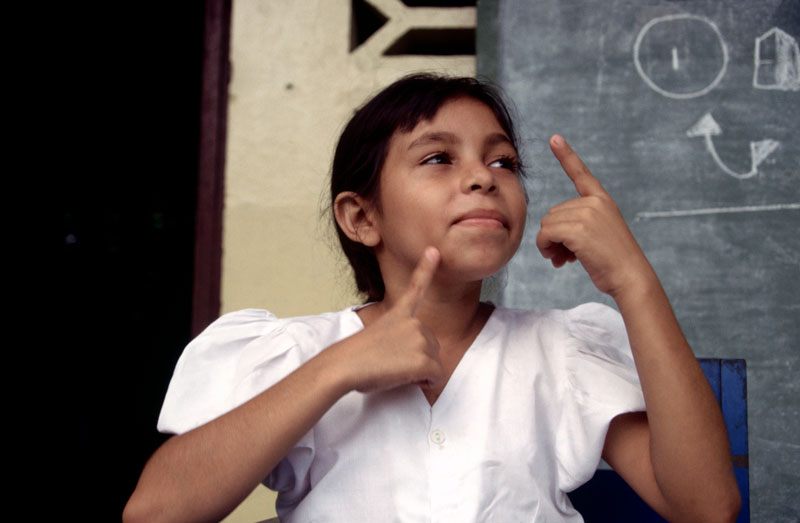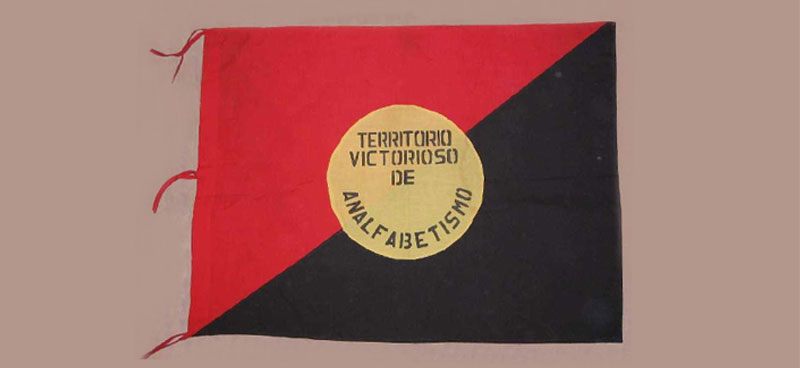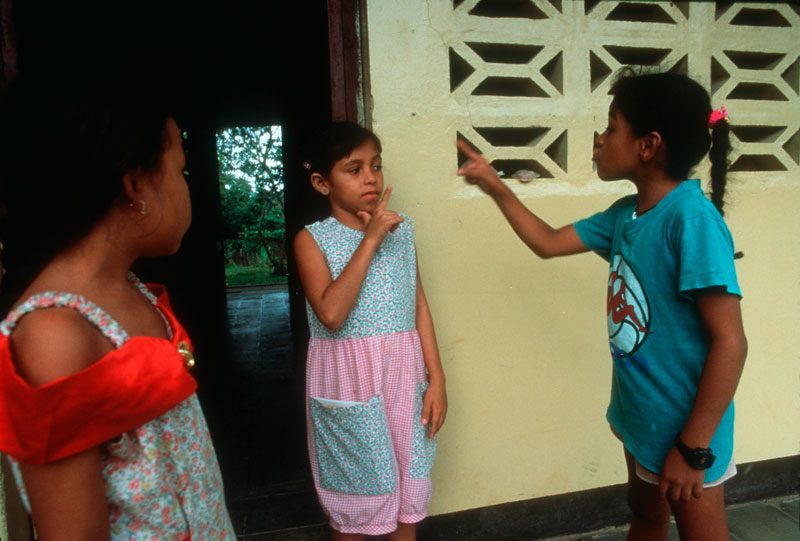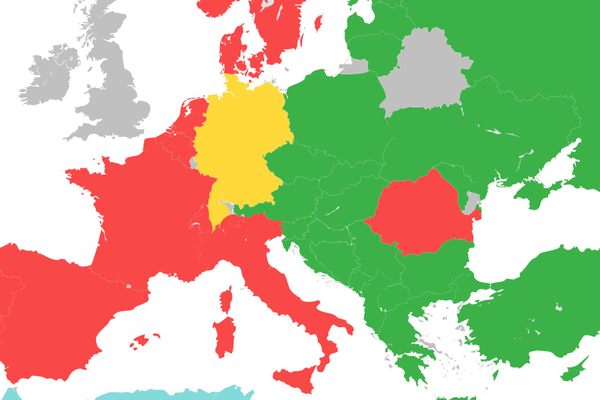How Deaf Children in Nicaragua Created a New Language
It happened on the playground.

Of all the changes within Nicaragua to come out of the overthrow of the Somoza regime by the Sandinistas in 1979, perhaps the least anticipated was the birth of a new language. Nicaraguan Sign Language is the only language spontaneously created, without the influence of other languages, to have been recorded from its birth. And though it came out of a period of civil strife, it was not political actors but deaf children who created the language’s unique vocabulary, grammar, and syntax.
When the Sandinista National Liberation Front gained power, they embarked on what has been described as a “literacy crusade,” developing programs to promote fluency in reading Spanish. One such initiative was opening the first public school for deaf education, the Melania Morales Special Education Center, in Managua’s Barrio San Judas. According to Ann Senghas, a professor of psychology at Barnard College who has studied NSL, it was the first time in the history of the country that deaf children were brought together in large numbers.
These children, who ranged in age from four to 16, had no experience with sign language beyond the “home signs” they used with family members to communicate broad concepts. American Sign Language, which has existed since the early 19th century, is used throughout the Americas and is often considered a “lingua franca” among deaf people whose first sign language is a national or regional one. But the first Nicaraguan deaf school did not use ASL or any signs at all. Instead, they focused on teaching children to speak and lip-read Spanish.

This educational strategy, known as “oralism,” has long been a subject of debate in deaf education, one that was particularly fierce in the United States where ASL originated. Around the turn of the 20th century, some deaf-education advocates believed that the ability to speak and lip-read a language would be more beneficial to deaf individuals than “manualism,” communication via sign language. By learning English, they argued, deaf individuals would be able to fully participate in U.S. society.
English immersion for the deaf was part of a wider effort, epitomized by the eugenics movement, to stamp out differences within the American population. Among the most vocal proponents of eugenics when it came to the deaf community was the inventor of the telephone, Alexander Graham Bell. Bell argued that if deaf people were allowed to communicate via sign language, their isolation from the hearing population would lead to more deaf marriages and, consequently, a larger deaf population.
“Oralism, Bell believed, allowed deaf people to leave their educational and cultural corners and participate in society at large,” writes Brian H. Greenwald, professor of history at the deaf institution Gallaudet University, via email. Bell, Greenwald notes, “used oralism as a form of assimilation.” It was a strategy that Bell hoped would eventually lead to the eradication of deafness in American society.
In Managua in the 1980s, too, though free of the influence of eugenicists, the Sandinistas focus on Spanish literacy resulted in the immersion of deaf students in Spanish speaking and reading skills. But while the country’s deaf children were being taught Spanish inside the classroom, outside the classroom they were spontaneously developing their own method of signed communication.
Though older and younger students attended separate classes during school hours, on buses and playgrounds the children quickly began to select “conventions” for necessary words. Such conventions occur when a community of speakers, who at home may have all used different signs to refer to an object or action, begin to consistently default to using just one, says James Shepard-Kegl. Kegl is co-director of the Nicaraguan Sign Language Project, which administers programs to empower the Nicaraguan deaf community through the use of sign language. “You start building a vocabulary this way,” he says.

All languages have grammar and syntax, but the first children at Managua’s deaf school had no model for how a language worked because they had been isolated from signed, spoken, and written language all their lives, Shepard-Kegl notes. When the children interacted, instead of adapting their signs to fit an existing language, they developed something unique. While the older students had more life experience, it was actually the younger kids that drove the language’s development. “As you get older, your language instincts tend to diminish,” says Shepard-Kegl. “A lot of those older kids weren’t generating grammar the way little kids did. They copied the grammar the little kids generated.”
No one knows exactly how many individuals are needed to generate a new language or what percentage of those individuals need to be young children. Smaller-scale isolated deaf-education programs had existed previously in 20th-century Nicaragua, Shepard-Kegl says, but the critical mass needed to spontaneously develop Nicaraguan Sign Language only occurred with the opening of Melania Morales. Within a few years, teachers and education officials recognized that something incredible was happening at the school and, in 1986, Nicaragua’s Ministry of Education invited the U.S. linguist Judy Kegl to visit as a deaf-education consultant.

For Kegl and the other linguists that accompanied her after the initial visit, the opportunity to identify and study Nicaraguan Sign Language was “extremely rare,” writes Senghas in her 1995 MIT doctoral dissertation, Children’s Contribution to the Birth of Nicaraguan Sign Language, which focuses on the years she spent working with Kegl. (Kegl is today co-director of the Nicaraguan Sign Language Project and married to Shepard-Kegl.) It’s an opportunity that owes much to the birth of NSL occuring in the 1980s, when researchers had access to video cameras and could accurately record exactly what was happening. “To my knowledge,” Senghas writes, “there has not been another case of linguists and psycholinguists documenting the birth of a language on a community-wide scale.”
This is not to say, however, that other independent community-based sign languages never existed. In fact, the linguistic world is rich with a wide variety of mutually unintelligible signed languages. Though American Sign Language and some other widely utilized sign languages, such as Chinese Sign Language and Indo-Pakistani Sign Language, have long histories, they were often inaccessible to deaf families and institutions in rural, mountainous, or politically-charged regions. In order to communicate manually, these communities had to develop their own signed languages. For example, in early-to-mid-20th century Jim Crow-era Raleigh, North Carolina, under-resourced and pedagogically isolated African-American deaf schools independently developed unique languages, says Susan Burch, an American Studies professor at Middlebury College. It’s something that has occurred many times in history.
Nicaraguan Sign Language similarly developed in a vacuum. Whereas American Sign Language could have extended into Nicaragua by the 1980s, as it did in neighboring Costa Rica where it combined with a locally developed sign language in the 1960s, Nicaragua’s geo-political isolation prevented ASL from entering the country, notes Shepard-Kegl. Not only did this allow for the independent creation of Nicaraguan Sign Language, but it helped the nascent form of communication to survive.

Around the world, deaf sign languages, including the one spoken among African Americans in Raleigh, have disappeared or changed significantly when a more widely used language has entered the region. Linguists refer to this displacement as “linguistic imperialism.”
It is a concept that has generated considerable controversy. Some linguists feel that the “contamination” of a local language by a more globally dominant one results in the marginalization of a native community because it supplants the indigenous form of communication with something from outside. Others believe that when dominant languages arrive, they are appropriated by indigenous communities, often combining with an existing language to create a distinctly local version. Deaf Costa Ricans born prior to the 1960s, for example, primarily use what is referred to as Old Costa Rican Sign Language. When ASL arrived in the country after the 1960s, its appropriation by the deaf community resulted in the creation of New Costa Rican Sign Language (sometimes called Modern Costa Rican Sign Language), around 60 percent of which is made up of ASL signs.
In Nicaragua today, changes in technology and communication have led to the increased use of American Sign Language within the deaf community. While ASL has not replaced the pristine, isolated NSL of the 1980s, which still dominates deaf education there, Nicaraguan Sign Language has begun a natural process of integrating elements of ASL. “Languages, by nature, borrow,” says Shepard-Kegl. “They either borrow or they perish.”
For all that linguists have learned from the study of Nicaraguan Sign Language, perhaps most important is the proof it has provided for a controversial theory of language. In the 1960s, Noam Chomsky suggested that children are born with an innate ability to learn human language. Babies are not given grammar lessons and yet they reliably learn grammar because they have inherent expectations about how languages function, says Shepard-Kegl. Kids “don’t know what the [grammatical] rule is but [they] expect that there is a rule.” In Managua’s first deaf school, there was no model and no one to guide the children in sign language and still a language was created in a way never observed before.










Follow us on Twitter to get the latest on the world's hidden wonders.
Like us on Facebook to get the latest on the world's hidden wonders.
Follow us on Twitter Like us on Facebook